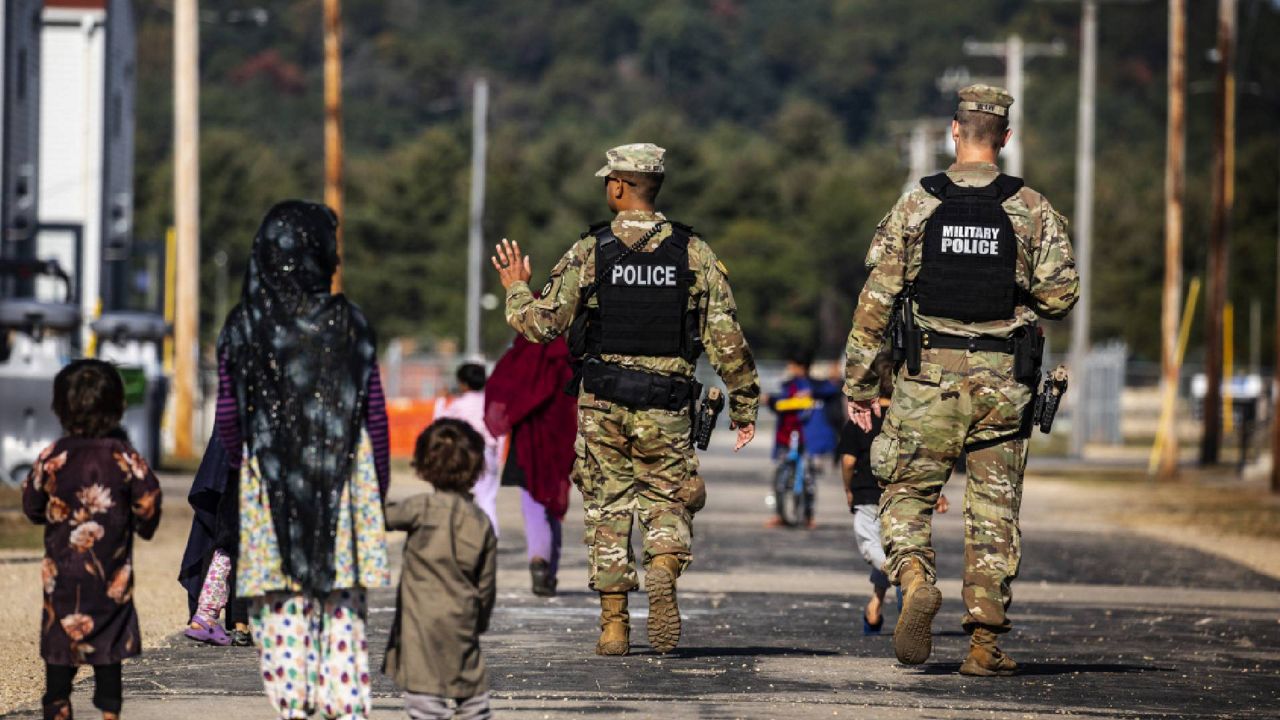Nearly six months since Kabul fell to the Taliban, the road ahead for thousands of Afghans remains uncertain even for those who made it out of their home country and are now under American jurisdiction.
Here’s a look at where things stands for Afghans who made it to the U.S., those waiting in third countries and the thousands still at risk in Afghanistan.
Approximately 75,000 Afghan people have made it to the United States, and the majority — about 68,000 — have been resettled in communities around the country, the Biden administration announced this week.
The final group of evacuees at Fort Pickett in Virginia recently departed, the Department of Homeland Security said, leaving 7,000 on the final two military bases housing people in Wisconsin and New Jersey.
Most of the Afghans resettling around the U.S. were those airlifted out of Afghanistan in the last two weeks of August, after the Taliban took over the country’s capital city. A vaccination campaign, lack of housing and the need to ramp up refugee resettlement infrastructure all slowed the process at first.
Yet now the majority of them face a tenuous path to permanent status in the United States, since they were mostly granted entry via humanitarian parole, which allows them to live and work in the U.S. but provides no guarantee of permanent residency.
Parole for Afghan evacuees lasts two years, but to stay in the country they are expected to apply for asylum within one year of entry if they’re not eligible for another visa category.
More than 36,000 Afghan evacuees are in that boat, according to a recent congressional report from the Department of Homeland Security and released by the Lutheran Immigration and Refugee Service.
Advocates are concerned about adding thousands of Afghans to an asylum application backlog already at more than 400,000. Congress passed legislation last year requiring that their asylum applications be processed within 45 days.
“In the next six months, I would expect there to be tens of thousands of Afghans filing for asylum,” said Adam Bates, policy counsel at the International Refugee Assistance Project.
Plus, Bates says, even Afghans with a visa pathway face an uncertain road — such as the near 37,000 who qualify for a Special Immigrant Visa (SIV) due to their or their family member’s work with the U.S. government or military.
Visa processing for the SIV program takes years, on average, meaning they may not get approved by the time their humanitarian parole expires.
“I imagine there are a lot of people who are in that SIV pipeline who may, in fact, get SIVs eventually, but they may still think it's in their best interest to file for asylum before the deadline just as an insurance policy,” Bates said.
The solution? Both the Biden administration and advocates say that Congress needs to pass an Afghan adjustment act, as lawmakers have done before for groups who fled their countries during times of crisis, such as Cubans in 1966 and Cambodian and Vietnamese people in 1975.
DHS Secretary Alejandro Mayorkas supports an adjustment act for Afghans, a spokesperson for his department confirmed to Spectrum News.
It’s ultimately up to Congress whether to adjust evacuees’ status and offer them a more direct path to permanent residency, but no legislation to do so has been introduced.
Meanwhile, thousands of Afghans evacuees remain at so-called “lily pad” locations around the world: Third country locations, including some U.S. military bases, that are hosting people before they travel on to the United States.
As of Feb. 4, there are approximately 3,000 Afghans living at these lily pad locations, with the largest group of people living at bases in Qatar, a DHS spokesperson confirmed to Spectrum News.
While there, Afghans must receive required vaccinations, including the measles, mumps and rubella shot and the COVID-19 vaccine.
They’re also screened for biometric and biographical information, which is then compared to U.S. government data and vetted by the Federal Bureau of Investigation and intelligence agencies.
“Only those evacuees who clear these comprehensive checks by our counterterrorism, intelligence, and law enforcement professionals are approved for onward travel to the United States,” a DHS spokesperson said.
Officials, veterans and volunteers still working to relocate Afghans acknowledge the process will take time, especially as people continue to leave Afghanistan on State Department-supervised flights.
“I was in Qatar last week, and I heard directly from their government that they are committed to this for the long-term,” said Shawn VanDiver, a Navy veteran who founded and leads the #AfghanEvac coalition, a group working to relocate vulnerable Afghans.
VanDiver, who regularly works with U.S. officials, said their goal is to ramp up to relocating 2,000 people every month.
The Afghans at lily pad locations are part of Operation Allies Welcome, the interagency effort to relocate and resettle them in the United States if they pass initial checks. They include people flown out of Afghanistan on a State Department supervised flight or a U.S. military flight in August.
Meanwhile, there are also thousands of Afghans living and waiting at a United Arab Emirates camp, many of whom may not qualify for U.S. relocation because they were flown out on a non-U.S. airline or a private charter flight, as Spectrum News reported in November.
Afghans in the UAE government-run camp say they’ve been isolated in their rooms with little outside time and no indication of when they’ll leave, while flights have been paused since December. Many arrived in August and have lived there for months with no connection to the outside world beyond their cell phones.
“We continue to work diligently to facilitate the relocation of all eligible individuals to the United States,” a State Department spokesperson told Spectrum News when asked about the UAe camp.
In a sign of potential progress, the U.S. embassy in the UAE announced on Thursday that 90 Afghans visited for immigrant visa interviews.
There are tens of thousands of vulnerable Afghans left in their home country, including many who worked alongside U.S. troops and U.S. government officials during the 20-year conflict, plus thousands of others who worked for U.S. based non-profits, media organizations or other affiliated groups.
Under Taliban restrictions, the State Department has been overseeing a trickle of flights since the military left Afghanistan at the end of August.
Since the U.S. military left the country on August 30, the State Department has assisted the departure of 495 U.S. citizens, 455 residents and 2,200 Afghans, according to a spokesperson.
But the number evacuated since the United States’ chaotic exit from Afghanistan is a small fraction of the number at risk, which some advocates estimated in late August to be as high as 250,000.
Flights also paused for about eight weeks in December, VanDiver said, but they’ve recently restarted and are going in “fits and starts,” with the goal of ramping up to a movement of 2,000 people per month.
The flights contain a mix of people, he said, including some Special Immigrant Visa (SIV) applicants, who include interpreters and others who worked alongside U.S. troops in combat.
As of the State Department’s latest report on the SIV program, there are nearly 20,000 applicants still in the pipeline plus their family members, though a small number may have made it out of Afghanistan since that count.
Asked on Wednesday whether the Biden administration still considered it a priority to evacuate those allies, White House press secretary Jen Psaki said: “We absolutely do.”
“I would say we are still committed to doing this. We are not naïve about the challenges, nor are we naïve about the conditions on the ground, which is why we are so focused on getting humanitarian assistance to the people in Afghanistan through trusted and reliable sources,” she added. “But it is a good sign that the flights have resumed.”
A group of more than 80 members of Congress sent a letter to President Biden on Wednesday calling on him to streamline resettlement of Afghan allies and other evacuees, including those at the UAE camp.
“Our Afghan allies risked everything to aid in our mission in their country, and it is a moral imperative that we keep the promises we made,” they wrote.
A State Department spokesperson confirmed that the department has “carried out several operations” to evacuate Afghans since Aug. 31, though they did not provide a specific number of flights or a prospective timeline, nor did they clarify how many SIVs had been evacuated during that time period.
“As [Secretary Antony Blinken] has said, there is no deadline on this effort,” they added.




